
The Clarksville Historic District is a national historic district located at Clarksville, Mecklenburg County, Virginia. It encompasses 171 contributing buildings, 2 contributing sites, and 1 contributing structure in the central business district and surrounding residential areas of the town of Clarksille. Notable buildings include the Planters Bank (1909), Planters Brick Tobacco Sales Warehouse, Gilliland Hotel, the Russell's Furniture, former Clarksville High School (1934), Clarksville Presbyterian Church, Mount Zion Baptist Church, Jamieson Memorial Methodist Episcopal Church (1901), St. Timothy's Episcopal Church (1917), and St. Catherine of Siena Roman Catholic Church (1947). Located in the district are the separately listed Clark Royster House and the Judge Henry Wood Jr. House.
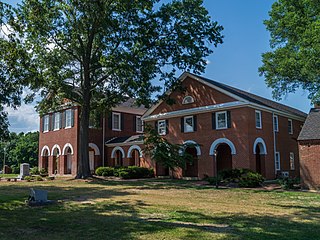
The Middlesex County Courthouse in Saluda, Virginia was built in 1852. It was listed on the National Register of Historic Places (NRHP) in 1978. The courthouse building "is a late but significant example of the arcaded-plan courthouse which had its precedent in Virginia's colonial courthouses and earliest civic buildings."

The Middlesex County Courthouse in Urbanna, Virginia was built starting in 1745. It was listed on the National Register of Historic Places (NRHP) in 1976. It has also been known as Old Middlesex County Courthouse and as Middlesex County Woman's Club.

Town of Halifax Court House Historic District is a national historic district located at Halifax, Halifax County, Virginia. The district includes 172 contributing buildings, 1 contributing site, 13 contributing structures, and 1 contributing object in the Town of Halifax. Resources include government, commercial, residential, religious, educational and industrial buildings that date from the early-19th Century to the mid-20th century. Notable buildings include the Rice House, Edmunds/Lewis Office (1869), People's Bank, Beth Car Baptist Church (1892), Christ Episcopal Church, Saint Luke's Christian Methodist Episcopal Church, Dr. Carter House, County Office Building (1915), Town of Halifax Swimming Pool (1930s), Municipal Building/ Fire Station (1950), Halifax Roller Mills (1915), Halifax Planing Mill, Halifax Department Store (1949), and Randolph Theater. Also located in the district is the separately listed Halifax County Courthouse.

Montpelier Historic District is a national historic district located at Montpelier, Hanover County, Virginia. The district includes 43 contributing buildings and 1 contributing site in the village of Montpelier. It includes residences, agricultural buildings, stores, businesses, a church, schools and libraries that illustrate the wide range of building types. Notable buildings include the old school (1876), Church of Our Savior (1882), Grange Hall (1899), Hobart Hardware, Montpelier School (1929), "Norway" House (1936), and "The Oaks" (1936). Located in the district and listed separately is the Sycamore Tavern, the only 18th-century building remaining in the district.
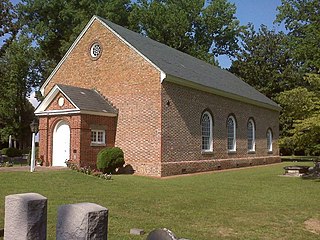
Christ Church is a historic Episcopal church located at Saluda, Middlesex County, Virginia. It was constructed in 1712–1714, and is a one-story, rectangular brick building with a gable roof. It measures 60 feet by 33 feet, 6 inches. The church was restored in 1843, and a gable-roofed vestibule added. Burials in the churchyard include Congressman Andrew Jackson Montague and Chesty Puller.

Hewick is a historic home located near Urbanna, Middlesex County, Virginia. It was constructed in 1678 by Christopher Robinson, whose progeny held considerable power in the colony before the American Revolution, during which some members became loyalists. It was listed on the United States National Register of Historic Places in 1978.

Lansdowne is a historic home located at Urbanna, Middlesex County, Virginia. It was constructed about 1740, and is a two-story, five-bay, "T"-shaped, brick dwelling in the Early Georgian style. It consists of a main section measuring 52 feet by 25 feet, with a rear wing of 36 feet by 18 feet. The front facade features a tall pedimented portico projecting from the center bay. It was the home of diplomat Arthur Lee (1791-1792), who is buried on the property in the family cemetery. Lee helped to negotiate and signed the 1778 Treaty of Alliance, which allied France and the United States together during the American Revolutionary War.
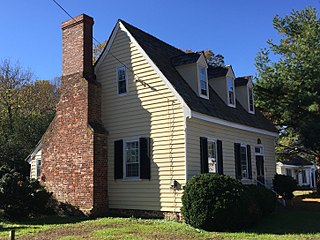
Wormeley Cottage, also known as the Wormeley-Montague House, is a historic home located at Urbanna, Middlesex County, Virginia. One of the few remaining 18th century buildings, it was built on orders of Ralph Wormeley about 1750, when the port town was established. He sold several town lots, including the cottage, in 1770 to James Mills.
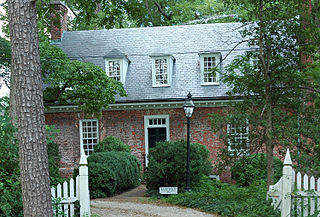
Sandwich, also known as the Old Customs House, is a historic home located at Urbanna, Middlesex County, Virginia. It was built about 1758, and is a three bay rectangular plan brick structure is built into the side of a steep hill with 1+1⁄2 stories on the west up-hill facade, and 2+1⁄2 stories on the east side. The house was renovated in the 1930s. Also on the property are a contributing brick wall, and a formal boxwood garden site, which includes four contributing garden buildings. Andrew Jackson Montague purchased the property in 1934. It is considered by many historians to be one of the oldest remaining buildings in the Urbanna Historic District.

James Mills Storehouse, also known as the Old Tobacco Warehouse, is a historic store located at Urbanna, Middlesex County, Virginia. It was built between 1763 and 1767, and is a 1 1/2-story, rectangular brick structure on a raised brick basement. It has a gable roof and full width front porch. It is a rare if not unique survivor of the type of storehouse which, being run by a resident factor of a British company, was not only connected with the sale of tobacco but which housed imported goods to be bought on credit by the planters.

Eastville Historic District is a national historic district located at Eastville, Northampton County, Virginia. The district encompasses 315 contributing buildings, 7 contributing sites, and 4 contributing structures in the county seat of Northampton County. The historic district contains a wide variety of residential, commercial, governmental, educational, social, religious, and funerary resources dating from 1731. Notable buildings include the courthouse (1731), clerk's office, Park Hall, Eastville Inn, Ingleside, Hickory Grounds, Maria Robins House, the Old Brick Store, Abdell Funeral Home, Edward Holland House, and Ailworth Hall. Also located in the district are the separately listed Cessford, Eastville Mercantile, and James Brown's Dry Goods Store.

Heathsville Historic District is a national historic district located at Heathsville, Northumberland County, Virginia. The district includes 81 contributing buildings, 12 contributing sites, 4 contributing structures, and 4 contributing objects in the county seat of Northumberland County. It is an assemblage of residential, commercial, and government buildings dating from the 18th through 20th centuries in a variety of popular architectural styles. The linear district is centered on the courthouse square. Notable buildings include the Northumberland Court House, the old county jail (1844), the former Methodist Protestant Church, Harding House, Belleville, Heathsville Masonic Lodge No. 109 (1894), Bank of Northumberland (1924), and the Heathsville United Methodist Church (1894). Located in the district and separately listed are Rice's Hotel, Oakley, St. Stephen's Church, Sunnyside, and The Academy.

Chatham Historic District is a national historic district located at Chatham, Pittsylvania County, Virginia. The district includes 188 contributing buildings, 2 contributing sites, and 1 contributing object in the central business district of the town of Chatham. The district includes a variety of government, commercial, residential, religious and educational buildings and structures dating from the early-19th century to the mid-20th century. At the center of the district is the separately listed Pittsylvania County Courthouse. Other notable buildings include the Judge Tredway House, Tunstall-Hargrave House, The Oaks (1832), Morea (1837), Hugh Weir House (1835), Planter's Bank, Thompson's Drug and Haberdashy Building, Corinth Christian Church, Emmanuel Episcopal Church (1881), Chatham Presbyterian Church (1886), Canada-Melton House, United States Post Office, Chatham High School, Chatham Elementary School (1925), Chatham Savings Bank, Masonic Temple, Collie Hotel/William Pitt Hotel, Beauty Plaza, and the Moses Building. Also located in the district and separately listed are the Clerk's Office, Bill's Diner, and Burnett's Diner.

Edinburg Historic District is a national historic district located at Edinburg, Shenandoah County, Virginia. The district encompasses 292 contributing buildings, 6 contributing sites, 3 contributing structures, and 3 contributing objects in the town of Edinburg. It includes a variety of commercial, residential, and institutional buildings dating primarily from the time of its incorporation in 1852 to the mid-20th century. They are in a variety of popular architectural styles including Colonial Revival, Italianate, and Queen Anne. Notable buildings include the Philip Grandstaff House (1787), Edinburg Hotel, St. John's United Methodist Church (1916), Edinburg High School (1932-1933), Rush House, The Hatch, Piccadilly House (1850), Pres Grandstaff House, Masonic Building (1879), Harshman House (1900), Rest Haven Inn, Edinburg Train Station, Edinburg Village Shops (1896), Wrenn Building, Edinburg Town Hall (1903), St. Paul's United Church of Christ (1911), and the Mantz House (1930). Located in the district is the separately listed Edinburg Mill.
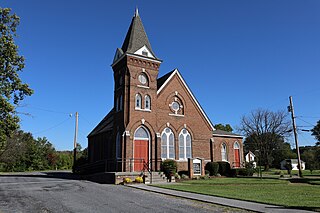
Riverton Historic District is a national historic district located at Front Royal, Warren County, Virginia. The district encompasses 66 contributing buildings and one contributing site in the town of Front Royal. It is a primarily residential district with buildings dating from the mid-19th century and including a diverse collection of building types and architectural styles. Notable buildings include Lackawanna (1869), the Old Duncan Hotel, the Riverton United Methodist Church (1883-1890), Dellbrook, the Carson Lime Company worker's houses, and the Old Riverton Post Office and Grocery. Located in the district and separately listed is Riverside.

Rugby Road–University Corner Historic District is a national historic district located at Charlottesville, Virginia. The district encompasses 173 contributing buildings in the city of Charlottesville. It includes a variety of commercial, residential, and institutional structures mirroring the University of Virginia's development between the 1890s and the Great Depression. It includes properties on Carr's Hill. Notable buildings include the Chancellor Building (1920), the Minor Court Building, Mincer's Shop Building 1920s), the Stevens-Shepherd Building, Buckingham Palace, St. Paul's Episcopal Church (1926–27), Madison Hall (1905), fraternity houses dating from 1902 to 1928, Fayerweather Hall (1893), the Bayly Museum (1934), Faculty Apartments building, Watts-Hillel House (1913-1914), and Hotopp-Watson House (1900). Also located in the district are the separately listed Anderson Brothers Building, Preston Court Apartments, and Wynhurst.

Wertland Street Historic District is a national historic district located at Charlottesville, Virginia. The district encompasses 25 contributing buildings in a two block residential section of the city of Charlottesville. It was primarily developed starting in the 1880s. Notable buildings include the Wertenbaker House, McKennie-Miller House, Ward-Brown-Gay House (1889), Marshall-Dabney-Cubbage House (1892), Bryan-Stallings House (1900), and Watson House (1905).
North End Historic District is a national historic district located at Newport News, Virginia. It encompasses 451 contributing buildings in a primarily residential section of Newport News. It is a compact, middle-class and upper middle-class residential neighborhood that arose during the period 1900–1935 in association with the nearby Newport News Shipbuilding and Dry Dock Company. The neighborhood includes notable examples of the Victorian, Colonial Revival, and Bungalow styles. Notable buildings include the Walter A. Post House (1902), John Livesay House (1906), J. E. Warren House (1905), W. L. Shumate House (1915), and Willet House.

St. Paul Historic District is a national historic district located at St. Paul, Wise County, Virginia. It contains 23 contributing buildings and 2 contributing structures in the central business district of St. Paul. Most contributing resources consist of commercial buildings dating from the 1920s to 1950s. Notable buildings include the Ennis House (1887), Hillman/Ennis House, the old St. Paul Hotel (1901), National Bank building, Gaiety Movie Theater (1920s), The Lyric, and Cavalier Theater/ Phillips Building.























